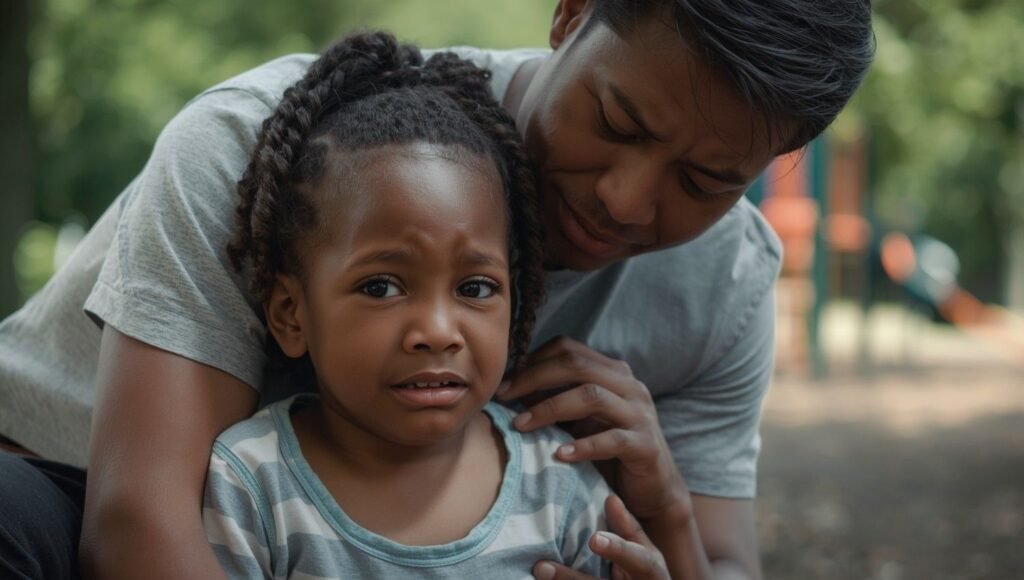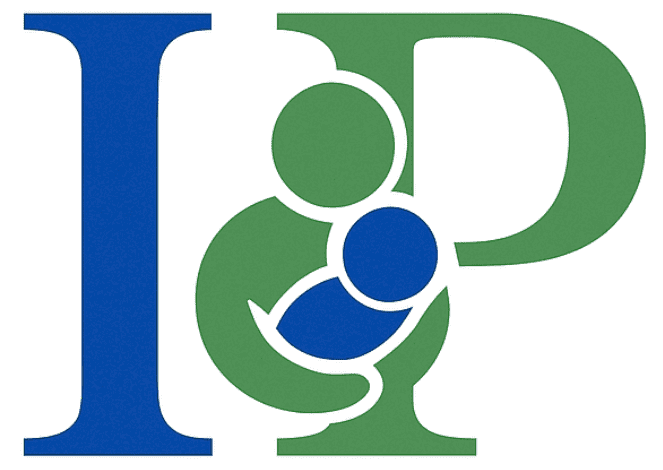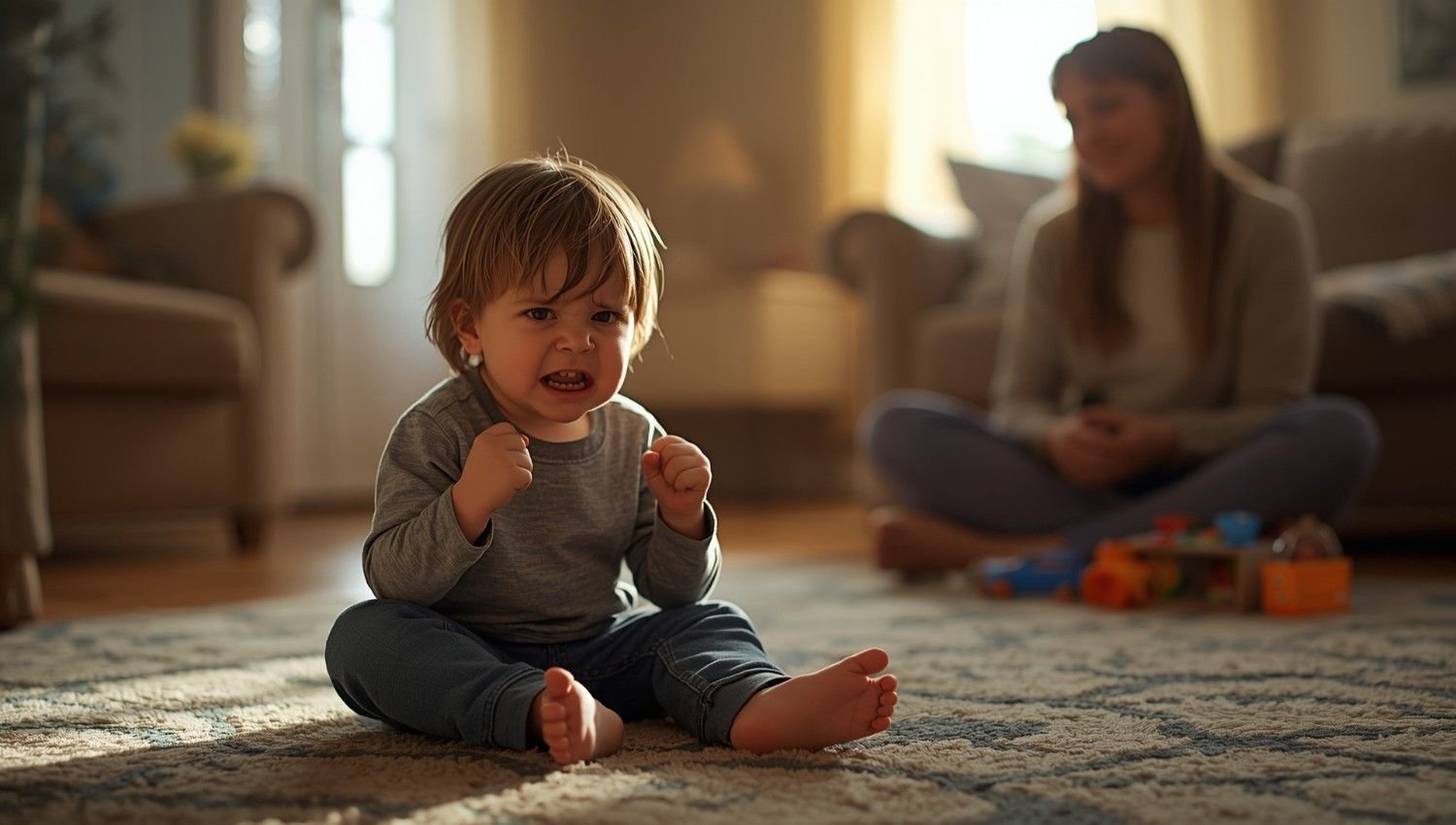When I first worked with children and their families through my programs, INFANT PARENTING, I noticed how angry feelings can quickly bubble into outbursts such as tantrums, whining, defiance, or even fighting. For many parents, it feels unsurprising that a child might melt down when they cannot express their emotions in a healthy or productive way. While anger is a normal and even useful emotion, helping kids see what isn’t fair or right, it can become a problem when behavior turns aggressive, like screaming, cursing, throwing objects, hitting, or biting. These explosive reactions can pose a serious risk to siblings, caregivers, or even the child themselves, and often create a scary, stressful experience for everyone involved.
Over time, I’ve seen how handling distress requires both evaluations and treatment plans, where the goal is teaching kids to manage emotions, build mature skills like problem-solving, and practice communication instead of lashing out. A distressed child might lack language, impulse control, or the ability to figure out what they need, which makes them seem manipulative when they’re really just overwhelmed. I encourage parents to stay calm, give consistent attention without giving in to every iPad demand, and focus on learning better ways for children to achieve control. Kids who are powerful and sensitive can be taught to regulate instead of acting out, and when they do, they feel good and less sorry afterward. With patience, variety in approaches, and helpful guidance, children can learn how to continue building effective strategies, stay down, and understand that even strong distress can be handled in more mature and better ways.
Is Your Child Struggling with Anger? Why is your child so angry? Discover Proven Strategies for Parents and Educators
When a child becomes angry, it’s often a reflection of deeper reasons that may not be obvious. I’ve seen many children in my work who struggled with anger, irritability, or aggression because of hidden factors like family members constantly arguing, friendship problems, or feeling bullied at school. The Anti-Bullying Alliance reminds us that bullying can leave a lasting impact, making a child feel stressed, anxious, or even fearful. Sometimes, schoolwork, exams, or puberty-related hormone changes can also cause frustration. As parents and teachers, it’s important to create space for talking, because many children can’t express their feelings clearly and may exhibit behaviors that interfere with their daily life.
Other factors that contribute to anger and aggression can include mental health conditions such as ADHD, autism, obsessive-compulsive disorder, or Tourette’s syndrome. I’ve noticed that genetics, biological role, and environment, especially when marked by trauma or family dysfunction can deeply shape how a child reacts. Certain parenting styles, especially when harsh or inconsistent with punishment, may trigger frustration and behavior that may harm rather than help. A child who wants to do well but faces these issues often struggles with coping, feeling stuck between what they’re doing and what they wish they could change. Understanding these roots of anger helps parents and educators guide children toward calmer, healthier emotional growth.

Work Together to Help Your Child Recognize the Signs of Anger
When working with a child who struggles to deal with anger, I’ve learned the best results come when you act as a team. You can tackle the problem together, especially if the child is younger, by making it fun and creative. For example, some parents use drawing to help children name their emotions, like a volcano that explodes when feelings get too strong. Helping them spot the signs of anger early, such as when their heart beats faster, their muscles tense, they clench their teeth or make a fist, or their stomach churns, teaches them to notice what’s happening inside. When you respond calmly, you also influence how they learn to handle anger and make positive decisions about what to do next. This shared awareness builds connection and control for both parent and child.
Anger Management Tips for Children
Every child has triggers that can set off anger, but with the right strategies for managing it, you can encourage them to count to ten or walk away from a tough situation. Teach them to breathe slowly and deeply, to clench and unclench their fists to ease tension, and to find a trusted person or a private place to calm down. The goal is to catch anger early and give your child the chance to regain control before emotions take over. In my experience, when parents guide their children with patience and understanding, those small, steady steps lead to lasting emotional balance.
1. Promote Daily Physical Activity and Play
From my experience, staying active is one of the best ways to reduce or even stop strong feelings of anger in both young and older people. Regular movement helps improve stress, anxiety, and depression, giving children a natural way to release energy and emotions. Simple activities like a walk, jogging, running, or cycling can make a big difference. The routine doesn’t need to be long; even short, simple bursts of play each day can help a child stay balanced. I’ve often seen how consistent movement allows them to calm down faster and feel more in control when emotions rise.
2. Focus on Positivity and Praise
Offering positive feedback is just as important as setting boundaries. When parents or teachers praise a child’s efforts, it strengthens their confidence and ability to manage anger in healthy ways. I’ve worked with many families who made great progress by learning together, celebrating even small improvements instead of focusing on setbacks. This approach helps children build trust and self-belief, reminding them that growth happens step by step and that every calm response is a success worth recognizing.
Understanding How Anger, Irritability, and Aggression Are Diagnosed in Children
When a young person shows angry, irritable, or aggressive behaviors, a full psychological or psychiatric evaluation is often needed. In my experience, this process usually begins when parents, a pediatrician, or a teacher notice ongoing behavioral problems. A psychologist or provider then works to understand these behaviors in context, sometimes with input from teachers, administrators, or older students. Assessing the child may include reviewing academic and medical records, as well as interviews with the parent to get a full picture. The goal is to identify whether the child may have a condition like oppositional defiant disorder (ODD) linked to argumentative, defiant, or spiteful patterns or conduct disorder (CD), which often violates others’ rights through bullying, stealing, truancy, or running away.
Sometimes, clinicians also explore disruptive mood dysregulation disorder (DMDD), where a child has angry outbursts, an irritable or depressed mood, and frequent rage attacks after provocation. In severe cases, juvenile justice or courts may get involved if the behavior breaks the law. The DSM provides the guidelines for such diagnoses, helping experts identify if symptoms come from a combination of disorders or even severe mood dysregulation. As someone involved in research, education, and advocacy, I’ve seen how understanding a child’s character and personality, not just the symptoms, can make all the difference in choosing the right treatment and support plan.
How Are Anger, Irritability, and Aggression Treated in Children?

When treating childhood anger, behavioral intervention and targeted therapies are often the most helpful. In my experience working with the Child Study Center, we use a mix of approaches that look closely at interpersonal dynamics and the child’s specific behavior problems. The main goal is to help children handle angry outbursts in complementary directions—not only to address the immediate behavior, but to guide them toward healthier habits. Effective treatment depends on consistency and teamwork between the child, parents, and teachers, allowing everyone to move forward with patience and understanding.
1. Cognitive Behavioral Therapy (CBT)
The cognitive behavioral therapy (CBT) approach helps a child acquire effective strategies for regulating angry emotions, thoughts, and behaviors. I’ve seen children respond positively when they understand how their thinking patterns affect their actions, making CBT a cornerstone of emotional recovery.
2. Emotion Regulation
Emotion regulation focuses on helping the child identify anger triggers and apply preventive strategies they can learn to use before frustration builds. This awareness gives children the tools to pause and respond thoughtfully.
3. Teaching Children Healthier Ways to Express and Manage Frustration
Through learning alternate methods to express and address frustration, a child and parent can weigh the consequences of each choice and minimize conflict at home or school. This shared process strengthens relationships and emotional control.
4. Building New and Effective Communication Strategies
Developing better communication strategies through role-play and practice can prevent and resolve anger-provoking situations. This new skillset helps children voice their needs calmly instead of reacting impulsively.
5. Parent Management Techniques (PMT)
Parent management techniques (PMT) teach parents to set a clear limit on outbursts by teaching alternative responses to misbehavior. Using positive reinforcement instead of harsh punishment improves interaction within families. Systems of rewards and motivation encourage children to enjoy spending time together, which strengthens bonds. In some cases, medication may help manage underlying conditions like anxiety or depression, improving the success of therapy. The frequency and intensity of outbursts often decide whether outpatient or inpatient services are needed as part of the child’s ongoing treatment.
Practical Behavioral Techniques for Managing Anger
Over the years, I’ve seen how behavioral techniques can help kids learn to regulate their emotions and improve anger management. These pointers work best when practiced daily, allowing children to recognize triggers and respond thoughtfully rather than react impulsively. Parents and educators play a crucial role in guiding them through these strategies with consistency and empathy.
1. Keep Calm and Stay in Control
When a child is raging, it’s hard to stay calm, but this is the first step toward gaining control. Avoid yelling or shouting responses, as they reduce your chance of reaching an aggressive or defiant child. Instead, model the emotional balance you want to teach, showing them how to manage strong emotions in the same way.
2. Stand Firm and Stay Consistent
It’s important not to encourage negative behavior by agreeing in order to make it stop. Stay firm and consistent, even when it feels difficult. Children learn boundaries through steadiness.
3. Acknowledge and Praise Positive Behavior
When your child has calmed, praise them for pulling themselves together and choosing to express feelings verbally and calmly. Recognize their efforts to compromise during a disagreement, reinforcing that calm behavior brings positive attention.
4. Guide Children to Practice Problem-Solving Skills
Encourage your child to practice problem-solving skills when they feel upset. Guide them in communicating feelings, finding solutions before conflicts escalate into aggressive outbursts. Ask them to think about how they might solve a problem differently next time; it builds confidence and control.
5. Use Time-Outs and Reward Systems Wisely
For younger children, time-outs and reward systems can correct misbehavior through consistent positive attention and reinforcement. Create a chart with points or tokens for appropriate choices, and let them move toward rewards as they grow older, keeping a balance between fun and structure.
6. Identify and Avoid Common Triggers
Identify triggers that cause frequent meltdowns, like homework, bedtime, playing Legos, or video games. When a child is asked to follow tasks or directions, offer warnings and support by preparing them for tough situations, such as leaving Grandma’s house or setting the table. This predictability gives them a sense of control and reduces emotional strain.
Understanding the Type of Tantrum Your Child Is Having
When a tantrum happens, understanding its severity is key to handling it properly. In my experience, some children respond best to nonviolent methods like staying calm and choosing to ignore negative behavior that seeks attention. This helps stop encouraging the pattern while keeping everyone safe from physical harm. Creating a safe environment with limited access to rewards until calm behavior returns can be very effective. Using time-outs doesn’t mean being emotionally harsh or isolating; research shows it works best when done with nurturing, supportive parenting. A simple strategy could be offering praise for positive behaviors, showing young children how emotional regulation looks by example. Having a chair or backup area with calm toys or games can make the process rewarding rather than punishing. The key is being immediate, consistent, and ensuring any consequence fits the act of aggression without reinforcing anger. For older children, letting them cool down in an isolated vicinity ensures safety, and if a situation turns extreme, calling 911 may be necessary to protect everyone involved.
Support Through Advanced Behavioral Techniques

If a child keeps lashing out in ways that feel frightening or disrupting to the family, seeking professional help can make a big difference. Behavioral therapies teach both children and parents how to manage aggression, lower stress, and strengthen the relationship between them. These techniques focus on managing difficult behavior in a positive way so the child can learn self-control while the family can enjoy calmer days together. Early guidance from a therapist or counselor helps prevent disruptive cycles from becoming long-term habits.
1. Parent-Child Interaction Therapy
In my experience, Parent-Child Interaction Therapy (PCIT) works wonders for children between certain ages who struggle with aggressive or defiant behaviors. During this process, a therapist coaches parents through exercises using an earbud, guiding them to give more positive attention and reinforce calm behavior. By offering consistent consequences for negative actions and encouraging a calm tone, parents learn to redirect misbehaviors before they escalate. The result is a stronger parent-child bond built on trust and understanding.
2. Parent Management Training
Parent Management Training (PMT) uses similar techniques as PCIT, where a therapist works with parents and their child to replace harsh reactions with structured guidance. It helps families learn effective responses that promote cooperation instead of conflict.
3. Collaborative and Proactive Solutions
The Collaborative and Proactive Solutions (CPS) program focuses on explosive or disruptive behavior by identifying lagging skills and setting limits in a respectful way. It helps teach children to respond to a situation calmly, making it an effective approach to prevent the next tantrum.
4. Figuring out Explosive Behavior
Repeated tantrums or meltdowns can be concerning, especially when preschool aggression becomes dangerous at school or with friends. When an older child keeps lashing out, it’s a sign of an underlying problem. Understanding these reasons and identifying patterns of aggressive behavior is the first step toward meaningful treatment.
5. ADHD
Children with ADHD often get frustrated in situations involving homework, bedtime (bed), or heavy demands. Helping them handle these triggers through structure and small goals reduces impulsive reactions.
6. Anxiety
When anxiety takes over, children may become anxious, filled with worries, and may lash out under pressure from school or home. Working with parents together helps a child regain confidence before frustration takes control.
7. Undiagnosed learning Disability
Sometimes a learning disability at school causes homework to feel too hard, leading the child to act out repeatedly rather than admit they can’t work through the problem. Identifying this early prevents shame and builds success.
8. Sensory Processing Issues
Children with sensory processing issues struggle to manage information from their senses. Noise, crowds, or tight clothes can make them anxious, uncomfortable, or overwhelmed, leading to actions that seem like aggression. Parents often feel mystified, but understanding these triggers is key to helping them cope.
9. Autism
For children on the autism spectrum, meltdowns can arise when they feel frustrated by unexpected change or intense sensory issues. They may appear anxious, agitated, or prone to strong reactions, but structured support and predictability help them regain calm more easily.
When Behavioral Plans Aren’t Enough: What to Do Next?
Sometimes, despite using many behavioral techniques, they simply aren’t enough to help a younger child or even an older one manage anger safely. I’ve seen professionals step in when a child becomes dangerous to themselves or others. In such cases, parents must focus on keeping the environment safe while working with experts who can treat the problem better through structured approaches and support systems that extend beyond home or school.
1. Medication
For some kids, medication can make a big difference, especially when underlying conditions like ADHD or anxiety make emotional control harder. Once a child becomes more reachable and teachable, therapy works more effectively. In extreme behavior cases, antipsychotic medications such as Risperdal may be prescribed. These are always partnered with techniques and therapy so that the child can be treated holistically, not just with pills.
2. Using Safe Holds When Necessary
Some parent training programs teach safe holds to prevent harm’s way during explosive episodes. It’s not about punishment but about learning the right way to keep both the adult and child secure until calm returns.
3. Exploring Residential Treatment Settings
When children display extreme behaviors, a residential treatment facility, hospital, or therapeutic boarding schools may be needed. These places combine pharmaceutical care with a stable structure and consistency around the clock. Kids learn self-control and appropriate behavior in a predictable home-like setting that prepares them for the real world.
4. Considering Day Treatment Options
In milder cases, day treatment programs allow a child with behavioral problems to stay at home while attending school part-time. With a strict plan and trained staff, these programs help kids handle crisis situations more safely. They attend during the day but return home afterward, learning to manage their lives step by step.
Explosive Children Thrive with Calm, Confident Parents
From my own experience, I’ve seen how challenging it can be for parents to handle an aggressive child, especially when behavioral approaches don’t seem to make an immediate difference. The truth is, children respond best to confident, calm, and consistent caregivers. These traits are key to successful anger management because they model how to regulate behavior even in stressful moments. Helping children develop skills takes patience and a willingness to try different techniques until you find what works. Over time, this steady effort leads to a stronger relationship and a happier home, where developing self-control becomes a natural result of trust and understanding.
Recognizing When a Child’s Anger Becomes Unhealthy
It’s unusual for a younger child to have daily tantrums that last more than a few minutes, especially if they involve crying, kicking, stomping, hitting, or pushing several times a week. When such behavior continues beyond kindergarten or appears in older children, it may not be developmentally appropriate anymore. In those cases, it’s wise to seek professional help in order to understand what’s really happening and to support the child before the patterns continue. With the right guidance, many children can outgrow these intense emotions and learn better ways to cope.
FAQ’s
- What are the effective ways to deal with children’s anger?
Dealing with children’s anger begins with understanding the cause behind it. Staying calm and confident allows parents and educators to model emotional regulation. Encouraging regular active play and exercise helps reduce stress, anxiety, and depression, while short activities like running, cycling, or a walk can stop negative feelings from building up. Simple behavioral techniques for anger management, such as time-outs, reward systems, and avoiding triggers, create a safe and positive environment where kids can learn to regulate their emotions effectively.
- How Can I Teach a Child to Control Their Anger?
Teaching a child to control their anger takes patience, praise, and positive feedback. Through Cognitive Behavioral Therapy (CBT), children can acquire practical strategies for regulating angry emotions, thoughts, and behaviors. Parents can also use Parent Management Training (PMT) or Parent-Child Interaction Therapy (PCIT), where a therapist coaches parents using consistent techniques to correct misbehaviors and reward calm responses. In my experience, learning alternate ways to express and address frustration, like communicating feelings and finding solutions to conflicts, is key to long-term success.
- How can I calm a child down when they’re angry?
When a child is raging, it’s hard to reach them if you start yelling or shouting back. It’s better to stay calm, model control, and teach the same behavior. Sometimes, ignoring negative attention-seeking tantrums while ensuring a safe environment is more effective. Offering a backup area with toys or games can help them settle. For younger children, gentle time-outs work best when they are consistent, positive, and followed by praise once the child has calmed down. These nonviolent, nurturing responses support emotional regulation and teach that calm behavior brings rewards.
- How do I help a child who struggles with extreme anger issues?
When behavioraltechniques aren’t enough, professionals can help treat underlying conditions like ADHD or anxiety, which may make a child more frustrated or anxious in daily situations. In more extreme cases, medication such as Risperdal can be partnered with therapy to make kids more reachable and teachable. Some children benefit from day treatment or residential settings, where trained staff offer structure, consistency, and self-control training. The key is to help the child and family work together, applying behavioral, emotional, and supportive strategies that encourage real progress and a happier home life.

